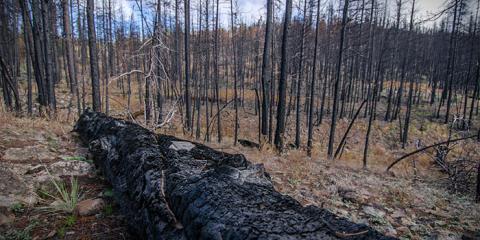Fires: past, present and future
October 10, 2013
As soggy as it’s been during September and early October, let’s remember that the 2013 wildfire season began early and looked like it would linger well into fall. Last June, Oregon’s wildfires captured national media attention as breezy, dry weather and fuel-laden forests combined to produce dramatic images that were flashed across the nation – at least, that is, until the still-smoldering Rim Fire burned into Yosemite National Park.
Then in September, the weather turned on a dime. Record rainfall doused flames. Portland received better than six inches of precipitation, and totals along the coast were much higher. Just like that it was over: Fires were out.
After the warm, dry summer, The Oregonian newspaper dutifully reported the weather phenomenon. The story in the online edition followed up with a series of blog posts in which self-appointed experts battled one another for the rhetorical high ground.
One two-word post was simple enough: “Global warming,” the anonymous blogger said, was the cause of the heavy rain. The predictable back-and-forth rant that followed was about the truth or fallacy of climate change.
Last week, I was reminded of that two-word blog as we drove through the Willamette and Deschutes national forests on the way to Lakeview. With fire season a fresh memory, most of these over-dense stands of trees looked like so much firewood rather than intact, healthy forests. Global warming – climate change – will no doubt have an impact on those trees in the future.
In Lakeview, OFRI’s board of directors hosted a tour of the 93,000-acre Barry Point Fire that during 2012 destroyed huge swaths of mixed-conifer forests, some of which were within the Fremont-Winema National Forest and the rest on private forestlands owned by The Collins Companies and other small forest landowners. It was a bad one. The fire started on a hot, dry August day in 2012. The cause was dry lightning, which experts say comes in concentrated bursts as thunderheads deliver electric jolts to treetops while scarce rain evaporates before reaching the bone-dry forest floor. Worse, these lightning-caused fires often start in remote places that are hard for firefighters to attack.
Such was the case with the Barry Point Fire. It was spotted soon after it started, but the conditions were ripe for fire, and it doubled in size quickly – and then doubled again and again. Typically, fires in that region travel from southwest to northeast, but the fates played another wild card: Winds came from the north, pushing the fire south as it galloped through public and then private forestlands.
Later, traveling back through south-central Oregon, we saw the remains of other fires – thousands of acres of bleached, standing snags from long-past conflagrations. Over Santiam Pass we saw the remains of the 2003 B&B Complex Fire that burned an area equivalent to that of the Barry Point Fire.
Our tour covered many details of the Barry Point Fire, which because of its remoteness did not draw much media attention. If asked, most Oregonians wouldn’t even remember it.
One large takeaway for me: that particular forest has seen extensive work by the local collaborative, the Lakeview Stewardship Group, to find common cause for how to treat the Fremont-Winema National Forest. Thinning to restore the forest has gone on for several years, but the Barry Point Fire didn’t happen in the restored stands. Ironically, rather than burning in forests already treated to restore fire resiliency, the Barry Point Fire burned up the next three years’ thinning projects. My hope is that Oregonians who work within these collaborative groups get to see their work fulfilled, and that wildfire can again fulfill its proper role in Oregon’s forests.
Dave Kvamme
Director of Communications
